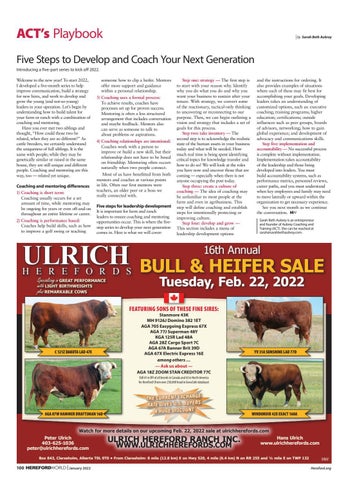ACT’s Playbook
| by Sarah Beth Aubrey
Five Steps to Develop and Coach Your Next Generation Introducing a five-part series to kick off 2022. Welcome to the new year! To start 2022, I developed a five-month series to help improve communication, build a strategy for new hires, and work to develop and grow the young (and not-so-young) leaders in your operation. Let’s begin by understanding how to build talent for your farm or ranch with a combination of coaching and mentoring. Have you ever met two siblings and thought, “How could those two be related, when they are so different?” As cattle breeders, we certainly understand the uniqueness of full siblings. It is the same with people; while they may be genetically similar or raised in the same house, they are still unique and different people. Coaching and mentoring are this way, too — related yet unique.
Coaching and mentoring differences 1) Coaching is short term: Coaching usually occurs for a set amount of time, while mentoring may be ongoing for years or even off-and-on throughout an entire lifetime or career. 2) Coaching is performance based: Coaches help build skills, such as how to improve a golf swing or teaching
someone how to clip a heifer. Mentors offer more support and guidance within a personal relationship. 3) Coaching uses a formal process: To achieve results, coaches have processes set up for proven success. Mentoring is often a less structured arrangement that includes conversation and maybe feedback. Mentors also can serve as someone to talk to about problems or aspirations. 4) Coaching relationships are intentional: Coaches work with a person to improve or build a new skill, but their relationship does not have to be based on friendship. Mentoring often occurs naturally when two people connect. Most of us have benefitted from both mentors and coaches at various points in life. Often our first mentors were teachers, an older peer or a boss we really connected with.
Five steps for leadership development It is important for farm and ranch leaders to ensure coaching and mentoring opportunities occur. This is where the fivestep series to develop your next generation comes in. Here is what we will cover:
ULRICH
H E R E F O R D S Specializing in GREAT PERFORMANCE with LIGHT BIRTHWEIGHTS plus REMARKABLE COWS
Step one: strategy — The first step is to start with your reason why. Identify why you do what you do and why you want your business to sustain after your tenure. With strategy, we convert some of the reactionary, tactical-only thinking to uncovering or reconnecting to our purpose. Then, we can begin outlining a vision and strategy that includes a set of goals for this process. Step two: take inventory — The second step is to acknowledge the realistic state of the human assets in your business today and what will be needed. How much real time is being spent identifying critical topics for knowledge transfer and how to do so? We will look at the roles you have now and uncover those that are coming — especially when there is not anyone occupying the post today. Step three: create a culture of coaching — The idea of coaching may be unfamiliar to most people at the farm and even in agribusiness. This step will define coaching and establish steps for intentionally protecting or improving culture. Step four: develop and grow — This section includes a menu of leadership development options
and the instructions for ordering. It also provides examples of situations where each of these may fit best for accomplishing your goals. Developing leaders takes an understanding of customized options, such as: executive coaching; training programs; higher education; certifications; outside influences such as peer groups, boards of advisors, networking; how to gain global experience; and development of advocacy and communications skills. Step five: implementation and accountability — No successful process is complete without implementation. Implementation takes accountability of the leadership and those being developed into leaders. You must build accountability systems, such as performance metrics, personnel reviews, career paths, and you must understand when key employees and family may need to move laterally or upward within the organization to get necessary experience. See you next month as we continue the conversation. Sarah Beth Aubrey is an entrepreneur and founder of Aubrey Coaching and Training (ACT). She can be reached at sarah@sarahbethaubrey.com.
16th Annual
BULL & HEIFER SALE Tuesday, Feb. 22, 2022
FEATURING SONS OF THESE FINE SIRES:
C 121Z DAKOTA LAD 47E
Stanmore 43K MH 9126J Domino 382 1ET AGA 705 Easygoing Express 67X AGA 77J Superman 48Y KGA 125R Lad 48A AGA 28Z Cargo Sport 7C AGA 67A Banner Brit 39D AGA 67X Electric Express 16E among others … — Ask us about — AGA 18Z ZOOM STAN CREDITOR 77C
YV 31A SUNSHINE LAD 77D
Still #1 in RFI of all breeds in Canada and #3 in North America for Hereford! (from over 250,000 head in GrowSafe database)
AGA 87W HAMMER DRAFTSMAN 16D
TH E CU RR EN T EX CH AN GE RATE GI VE S U. S. BU YE RS A HU GE DI SC OU NT
WINDIMUIR 42X EXACT 160A
Watch for more details on our upcoming Feb. 22, 2022 sale at ulrichherefords.com Peter Ulrich 403-625-1036 peter@ulrichherefords.com
ULRICH HEREFORD RANCH INC. WWW.ULRICHHEREFORDS.COM
Hans Ulrich www.ulrichherefords.com
Box 843, Claresholm, Alberta T0L 0T0 • From Claresholm: 8 mile (12.8 km) E on Hwy 520, 4 mile (6.4 km) N on RR 255 and ¼ mile E on TWP 132
100
| January 2022
Hereford.org


